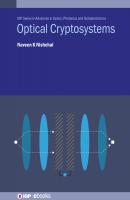Optical Cryptosystems. Naveen K. Nishchal
Чтение книги онлайн.

Читать онлайн книгу Optical Cryptosystems - Naveen K. Nishchal страница 6
Название: Optical Cryptosystems
Автор: Naveen K. Nishchal
Издательство: Ingram
Жанр: Отраслевые издания
isbn: 9780750322201
isbn:
The art and science of concealing information/data is called cryptography. The information/data/message to be concealed is called a plaintext (clear text) and the concealed form of message is called a ciphertext (encrypted text). In other words, cryptography is a process of converting plaintext into ciphertext and vice versa. The process of conversion from plaintext to ciphertext is called encryption and the reverse process that retrieves plaintext from ciphertext is called decryption. The ciphertext is a message that cannot be understood by anyone or is a meaningless message. A cipher is an algorithm used for encryption and decryption. The ciphertext is stored and transmitted to the intended user. The cryptography is not only used for protecting the information from theft or alteration but it is also used for user authentication [5–7].
A cryptosystem, also referred to as a cipher system, is an implementation of cryptographic techniques and their accompanying infrastructure to provide information security services. Though cryptographic techniques have been in use for protecting information for thousands of years, the systematic study of cryptology as a science started around one hundred years ago. Therefore, cryptology is considered as a young science. Julius Caesar (around 100 BC) was known to use a form of encryption to convey secret messages to his Army Generals. The substitution cipher, known as the Caesar cipher is probably the most mentioned historic cipher in academic literature [3]. In this method, each character of a plaintext is substituted by another character to form the ciphertext. The variant used by Caesar was a shift by three ciphers. Each character was shifted by three places, so the character ‘A’ was replaced by ‘D’ and character ‘B’ was replaced by ‘E’ and so on. The characters would wrap around at the end, so character ‘X’ would be replaced by ‘A’. An example of the character substitution based on Caesar’s algorithm has been shown in figure 1.1.
Figure 1.1. Example of character substitution based on Caesar’s algorithm.
Figure 1.2 shows the schematic of the modern encryption-decryption process. A plaintext is converted into a ciphertext through the encryption process, which upon use of correct keys returns the decrypted plaintext [4].
Figure 1.2. Encryption-decryption process.
A basic cryptosystem has the following components [5]:
Plaintext
Encryption algorithm
Ciphertext
Decryption algorithm
Encryption key
Decryption key.
A plaintext is converted into a ciphertext by applying the encryption algorithm and encryption key. The key space is a string of different keys that can be used to break the algorithm. It is generally accepted that a secure algorithm should use a key with length greater than 100 bits, because the number of bit permutation operations required to try 2100 keys is considered to be computationally infeasible for a conventional digital computing technique. A secure encryption algorithm is extremely sensitive to its keys. Various encryption algorithms have been developed and are being practiced. A ciphertext returns the plaintext only after use of the appropriate decryption algorithm and correct decryption key. A slight change to the keys would result in different ciphers. Thus for the successful retrieval of the plaintext, use of the correct decryption key and appropriate decryption algorithm is a must. In different types of cryptosystems, different encryption and decryption algorithms are used and correspondingly different encryption and decryption keys are generated.
While cryptography is the science of securing data, cryptanalysis is the science of analyzing and breaking a secure communication. The professionals involved in the process are called cryptanalysts. They are also called attackers. Attackers always wish to get the access of the encryption-decryption key so that plaintext can be retrieved. In classical cryptanalysis, several things are involved in the process, such as the interesting combination of analytical reasoning, the application of mathematical tools, pattern finding, patience, determination, and luck. With the passage of time, newer and reliable cryptosystems have been developed. On the other hand, attackers have also been creating improved logic to analyze the process to access the data. The pace of the development of information security technology is characterized by the creation of new methods and means of protection in the context of the storage, processing, and transmission of information. To date, much attention has been paid to the development of newer methods of intellectualization of various automated systems.
The cryptology embraces both cryptography and cryptanalysis. The cryptography can provide the following services [6].
Confidentiality (secrecy): it ensures that no one can read the concealed message except the authentic receiver. The data is kept secret from those who do not have proper credentials, even if that the data travels through an insecure medium.
Integrity (anti-tampering): it is assured that the authentic receiver has received message and it has not been altered in any way from the original.
Authentication: it helps establish identity for authentication purposes. Actually, the process proves one’s identity.
Non-repudiation: it is a mechanism to prove that the sender really sent this message. Neither the sender nor the receiver can deny the transmission of the message.
Access control: it requires that the access to information resources may be controlled by or for the authentic system.
Availability: it requires that the system assets be available to authorized personnel, as and when needed.
1.2 Types of cryptography
Depending on the common uses, cryptography can be classified into two categories; symmetric key cryptography and asymmetric key cryptography. СКАЧАТЬ